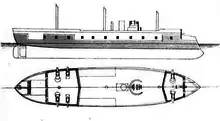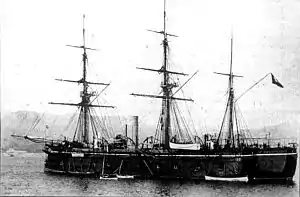Principe Amedeo-class ironclad
The Principe Amedeo class was a pair of ironclad warships built for the Italian Regia Marina (Royal Navy) in the 1870s and 1880s. They were the culmination of a major naval construction program designed to give Italy a powerful fleet of ironclads. The two ships, Principe Amedeo and Palestro, were the last Italian ironclads to feature sailing rigs and wooden hulls. They were armed with a battery of six 254 mm (10 in) guns and were capable of a speed in excess of 12 knots (22 km/h; 14 mph). The ships had uneventful careers, spending much of it in Italy's colonial empire. By the late 1880s, they were withdrawn from service and employed in secondary roles, first as headquarters ships for harbor defenses. Principe Amedeo was converted into a depot ship in 1895 and was discarded in 1910, while Palestro was used as a training ship from 1894 to 1900 before being scrapped between 1902 and 1904.
 Painting of Principe Amedeo | |
| Class overview | |
|---|---|
| Name | Principe Amedeo class |
| Builders | |
| Operators | |
| Preceded by | Affondatore |
| Succeeded by | Duilio class |
| Built | 1865–1875 |
| In commission | 1874–1900 |
| Completed | 2 |
| Retired | 2 |
| General characteristics [lower-alpha 1] | |
| Type | Ironclad warship |
| Displacement | |
| Length | 79.73 m (261 ft 7 in) |
| Beam | 17.4 m (57 ft 1 in) |
| Draft | 7.9 m (25 ft 11 in) |
| Installed power |
|
| Propulsion |
|
| Speed | 12.2 knots (22.6 km/h; 14.0 mph) |
| Range | 1,780 nmi (3,300 km) at 10 kn (19 km/h; 12 mph) |
| Complement | 548 |
| Armament |
|
| Armor |
|
Design
In 1862, the Italian government under Prime Minister Urbano Rattazzi and his naval minister Carlo Pellion di Persano made the decision to build a fleet of ironclad warships.[1] The Italian fleet had already acquired a pair of small, French-built armored frigates of the Formidabile class, and two more vessels of the Re d'Italia class had been ordered from the United States. Five more ironclads were ordered from foreign shipyards, three wooden steam frigates already under construction were converted into armored ships, and four more ironclads were ordered from Italian shipyards. The two Principe Amedeo-class ships were the last two of this first generation of Italian ironclads. The design for Principe Amedeo was prepared by Inspector Engineer Giuseppe De Luca. He had initially planned on using entirely wooden hulls for the ships, but had changed to composite wood and iron construction by the time the ships were laid down.[2]
General characteristics and machinery

The two ships differed slightly in size. Principe Amedeo was 79.73 meters (261 ft 7 in) long between perpendiculars, while Palestro was 78.82 m (258 ft 7 in) long. Principe Amedeo had a beam of 17.4 m (57 ft 1 in) and a draft of 7.9 m (25 ft 11 in); Palestro's beam measured 17.3 m (56 ft 9 in), and she had a draft of 8 m (26 ft 3 in). Both ships displaced 5,761 long tons (5,853 t) normally, but Principe Amedeo displaced 6,020 long tons (6,120 t) at full load and Palestro reached 3,218 long tons (3,270 t). The ships had an inverted bow with a naval ram below the waterline. Their superstructure was minimal, consisting primarily of a small conning tower forward. They had a crew of 548 officers and men.[3]
The ships' propulsion system consisted of one single-expansion steam engine that drove a single screw propeller, with steam supplied by six coal-fired, cylindrical fire-tube boilers. The boilers were trunked into a single funnel. The lead ship's engine produced a top speed of 12.2 knots (22.6 km/h; 14.0 mph) at 6,117 indicated horsepower (4,561 kW), while Palestro made 12.85 kn (23.80 km/h; 14.79 mph) at the same horsepower. They could steam for 1,780 nautical miles (3,300 km; 2,050 mi) at a speed of 10 knots (19 km/h; 12 mph). The ships were barque-rigged to supplement the steam engine; Principe Amedeo and her sister were the last rigged ironclad to be built by Italy. The ships' sail area were 36,738 square feet (3,413.1 m2) for Principe Amedeo and 37,361 sq ft (3,471.0 m2) for Palestro.[3]
Armament and armor
Palestro and Principe Amedeo were both armed with a main battery of six 254 mm (10 in) guns, though they were mounted differently in each ship. Principe Amedeo carried hers in a single armored casemate located amidships, while Palestro's guns were mounted in three armored casemates. The first was located forward, toward the bow, the second and third were placed close to the stern on each side of the ship. Both ships also carried an 279 mm (11 in) gun that was mounted forward as a bow chaser. Later in her career, Principe Amedeo received a secondary battery of six 74 mm (2.9 in) guns and six machine guns, along with two torpedo tubes.[4]
The two ships were protected by iron belt armor that was 221 mm (8.7 in) thick and extended for the entire length of the hull. The casemates were protected with 140 mm (5.5 in) of iron plating, and the small conning tower had 61 mm (2.4 in) thick iron plates.[3]
Ships

| Name | Builder[3] | Laid down[3] | Launched[3] | Completed[3] |
|---|---|---|---|---|
| Principe Amedeo | Regio Cantiere di Castellammare di Stabia | August 1865 | 15 January 1872 | 15 December 1874 |
| Palestro | Arsenale di La Spezia | 30 September or 2 October 1871 | 11 July 1875 |
Service history
Neither ship had a particularly eventful career. They were completed too late to take part in the final stages of the wars of Italian unification. Instead, they were assigned to the Italian colonial empire, with occasional stints in the main Italian fleet.[5] In 1880, Palestro took part in a naval demonstration off Ragusa in an attempt to force the Ottoman Empire to comply with the terms of the Treaty of Berlin and turn over the town of Ulcinj to Montenegro.[6] The following year, Principe Amedeo was involved in a collision with the ironclad Roma during a hurricane, though neither ship was damaged.[7]
In the late 1880s, both ships were withdrawn from frontline service and employed as headquarters ships for the defense of Taranto—Principe Amedeo—and La Maddalena—Palestro. Principe Amedeo was stricken from the naval register in 1895 and used as an ammunition depot ship in Taranto until 1910, when she was sold for scrap. Palestro was employed as a training ship between 1894 and 1900, when she too was stricken from the register. She was broken up between 1902 and 1904.[3]
Footnotes
Notes
- Figures are for Principe Amedeo
Citations
- Sondhaus, p. 11.
- Fraccaroli, pp. 337–340.
- Fraccaroli, p. 340.
- Clowes, p. 376.
- Ordovini, Petronio, & Sullivan, p. 358.
- London News, p. 278.
- "Stray Foreign Facts" (PDF). The New York Times. 23 November 1881.
References
- Clowes, W. Laird (1905). The Naval Pocket-Book. London: W. Thacker & Co.
- Fraccaroli, Aldo (1979). "Italy". In Gardiner, Robert (ed.). Conway's All the World's Fighting Ships 1860–1905. London: Conway Maritime Press. pp. 334–359. ISBN 978-0-85177-133-5.
- Ordovini, Aldo F.; Petronio, Fulvio & Sullivan, David M. (December 2014). "Capital Ships of the Royal Italian Navy, 1860–1918: Part I: The Formidabile, Principe di Carignano, Re d'Italia, Regina Maria Pia, Affondatore, Roma and Principe Amedeo Classes". Warship International. Vol. 51, no. 4. pp. 323–360. ISSN 0043-0374.
- Sondhaus, Lawrence (1994). The Naval Policy of Austria-Hungary, 1867–1918. West Lafayette: Purdue University Press. ISBN 978-1-55753-034-9.
- "The Naval Demonstration in the Adriatic". The Illustrated London News. London: George C. Leighton. 18 September 1880. p. 278.
External links
- Principe Amedeo Marina Militare website (in Italian)